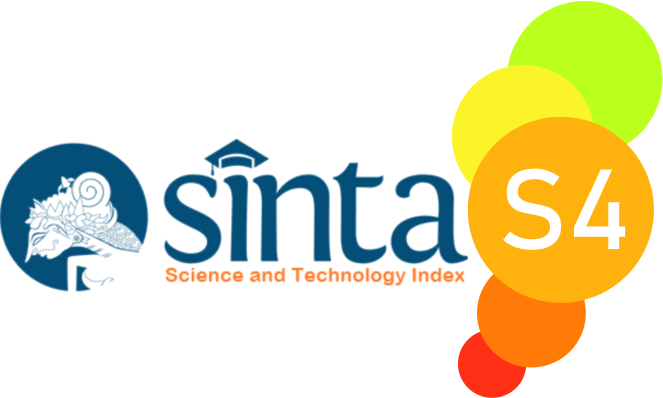Self Directed Learning Scale at University Context
Abstract
This research was carried out to investigate a relationship between self-directedness, self-involvement, expressive language, self-assessment, language varieties, metacognitive skills, editing and problem solving, text processing, knowledge rehearsal, idea planning, goal oriented monitoring and evaluating, peer learning, feedback handling, interest enhancement, motivational self-talk, and emotional control and the main and forming factors of self-directedness, self-involvement, expressive language, self-assessment, language varieties, metacognitive skills, editing and problem solving, text processing, knowledge rehearsal, idea planning, goal oriented monitoring and evaluating, peer learning, feedback handling, interest enhancing, motivational self-talk, and emotional control of self directed learning. A convenience sample approach was used to recruit English majors from a range of State University of Yogyakarta. All participants were recruited intentionally, and that they were informed that they might leave the study at any moment either during collecting data. The participant criteria include second-year English major students from various State Universities of Yogyakarta. As the result of pearson correlation in this research, it was found that there was a substantial relationship between the variables examined in this research. Moreover, as the result of factor analysis in this research was found that from the 11 variables included in the research namely self involvement, expressive language, self assessment, language varieties, metacognitive skills, editing and problem solving, Cognition, Metacognition, Social Behavior, and Motivational Regulation, they can be grouped into two main factors. The implications of these findings lie in a deeper understanding of the underlying conceptual structure of self-directed learning in a university context. With the identification of the key factors emerging from these variables, a more focused approach can be developed to enhance students' self-directed learning. This can also aid in the development of more precise and measurable assessment instruments to gauge progress in crucial aspects of self-directed learning. Thus, the implications of these findings can enrich teaching and learning practices in higher education settings.
References
Aghayani, B., & Janfeshan, K. (2020). The Effect of Self-Directed Learning on EFL Learners’ Writing Performance. International Journal of Research in English Education, 5(3), 78–89. https://doi.org/10.29252/ijree.5.3.78
Ayyildiz, Y., & Tarhan, L. (2015). Development of the self-directed learning skills scale. International Journal of Lifelong Education, 34(6), 663–679. https://doi.org/10.1080/02601370.2015.1091393
Deane, P., Odendahl, N., Quinlan, T., Fowles, M., Welsh, C., & Bivens-Tatum, J. (2008). Cognitive Models of Writing: Writing Proficiency As a Complex Integrated Skill. ETS Research Report Series, 2008(2), i–36. https://doi.org/10.1002/j.2333-8504.2008.tb02141.x
Du, F. (2013). Student Perspectives of Self-Directed Language Learning: Implications for Teaching and Research. International Journal for the Scholarship of Teaching and Learning, 7(2). https://doi.org/10.20429/ijsotl.2013.070224
Flower, L. S., & Hayes, J. R. (1977). Problem-Solving Strategies and the Writing Process. College English, 39(4), 449. https://doi.org/10.2307/375768
Indrawan, F., Daristin, P. E., & Laili, E. N. (2023). The Influence of Duolingo Application to EFL Classroom Students’ Motivation in Learning English. Journey: Journal of English Language and Pedagogy, 6(3), 626–633.
Jarvis, P. (2010). Adult education and lifelong learning: Theory and practice. In Routledge (Vol. 63, Issues 3–4). https://doi.org/10.1007/BF01027387
Kim, J., Lee, H., & Cho, Y. H. (2022). Learning design to support student-AI collaboration: Perspectives of leading teachers for AI in education. Education and Information Technologies, 27(5), 6069–6104.
Knowles, M. (1975). Individual Schools , Stating Learning Objectives Is the Clearest ,. 256–257.
Loeng, S. (2020). Self-Directed Learning: A Core Concept in Adult Education. Education Research International, 2020, 1–12. https://doi.org/10.1155/2020/3816132
Lovejoy, K. B. (2009). Self-Directed Writing: Giving Voice to Student Writers. English Journal, 98(6), 79–86.
Olivier, L. (2016). The effect of an academic literacy course on first-year student writing: A case study. (Doctoral Dissertation, North-West University (South Africa), Potchefstroom Campus)., May.
Ramadhanty, F., Mandalika, D., & Sumarni, S. (2023). The Effectiveness of Self-Directed Learning for English Language Education: A Systematic Literature Review. English Language & Literature International Conference (EELiC), 6(1), 348–356. https://jurnal.unimus.ac.id/index.php/ELLIC/index
Rashid, T., & Asghar, H. M. (2016). Technology use, self-directed learning, student engagement and academic performance: Examining the interrelations. Computers in Human Behavior, 63, 604–612. https://doi.org/10.1016/j.chb.2016.05.084
Ryan, G. (1993). Student Perceptions about Self-directed Learning in a Professional Course Implementing Problem-based Learning. Studies in Higher Education, 18(1), 53–63. https://doi.org/10.1080/03075079312331382458
Tremblay, K., Lalancette, D., & Roseveare, D. (2013). Assessment of Higher Education Learning Outcomes (Vol. 1). OECD. https://doi.org/10.1007/978-94-6091-867-4
Wilcox, S. (1996). Fostering Self-directed Learning in the University Setting. Studies in Higher Education, 21(2), 165–176. https://doi.org/10.1080/03075079612331381338
Copyright (c) 2024 Masrul Masrul, Sri Yuliani

This work is licensed under a Creative Commons Attribution-ShareAlike 4.0 International License.

Journey: Journal of English Language and Pedagogy by http://ejurnal.budiutomomalang.ac.id/index.php/journey/index is licensed under a Creative Commons Attribution-ShareAlike 4.0 International License.






